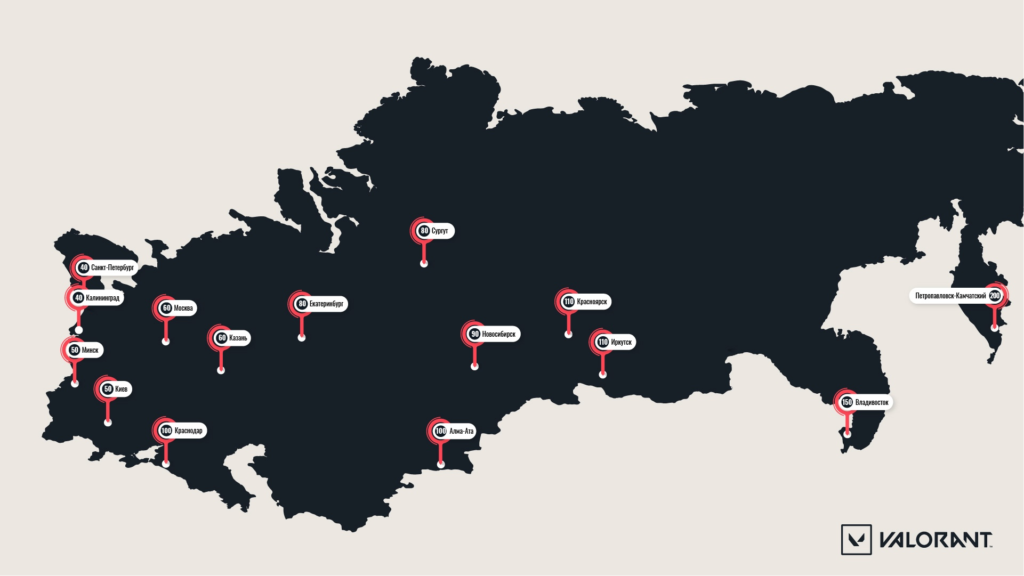Riot Talks About VALORANT Netcode (Smoothing), Ping Testing, Server Locations and Connection Quality – No Servers in Russia for Now.
Where most of the world only got two official blog posts about VALORANT today, Russian players got an additional post. In this post Riot talks a bit about netcode and high ping mitigation, how they tested pings, gives tips for better connection quality and also announces that Russian players won’t get servers hosted in their country – for now.
Riot says that VALORANT is still committed to provide a gameplay experience with the highest possible quality of connection, so that the outcome of the game depends as much as possible on the players skill. This means great optimization for lower-end systems, free 128 tickrate servers and a powerful anti-cheat system from day one – and also something they call “smoothing” of the FPS. (See my first thoughts on the smoothing at the end of the post.)
Riot continues that they’re working hard on reducing the network latency for everybody, by building data centers around the world and partnering with ISPs, unfortunately this won’t help all players. Russia, Ukraine, Belarus, Kazakhstan and other CIS countries cover eleven different time zones, they have an uneven distribution of the population and player numbers fluctuate – this makes it not feasible to provide the same distance and low network latency for every player in every region for the near future.

Riot shares a map of pings that players should expect in their city. The western cities being closest to the European servers will experience the the lowest pings
They want to make clear that those are average results from Russian beta players, so you might have a slightly slower or higher ping than listed – and that your ping is of course also depended on various other factors, like your connection quality overall (potential routing problems, etc.).
A Shimmer of Hope
If VALORANT is successful in the region, Riot Games will consider options to lower those pings, for example with servers in Japan for the players in the east or even setting up servers directly in Russia and other CIS countries.
Factors affecting the connection quality
Riot continues to talk about how the location of servers, the game’s optimization, modern netcode and delay smoothing build a create foundation for the game, but that other factors also can affect the quality of the network connection and game.
List of factors for a better gameplay experience and practical tips – by Riot Games
- Make sure to not overload your connection – don’t download or upload large amounts of data (including on your local network).
- You should always prefer a wired connection over a wireless connection. A good way to reduce potential lagging and less chance of packet loss.
- Even though VALORANT is optimized for very low-end PCs too, in the end means more power a more stable frame rate. Not enough performance can also lead to worse network performance.
- Bad routing by your ISP. The quality of your connection can vary significantly even in the same city – in this case you should open a support ticket with your ISP and tell them about the situation – they might be able to fix it.
Riot encourages every player to try to create the best possible conditions for themselves.
Thoughts on “Smoothing”
Their post unfortunately doesn’t dive really into the topic, so it’s hard to say how exactly they implemented that smoothing, but I’ll still try my best to explain what roughly is meant by this. (Probably a topic I will write more on in the future and who knows, maybe one of the devs of the engine/network team would be up to talk to us or give an interview about it. I’d love to.)
Even though VALORANT has “128 tick servers” which is great (means the server calculates and sends the state of the game 128 times a second (hz) to the players client), the game client renders the game faster than 128 times a second (Your FPS).
Let’s say a running enemy is calculated a 128 times by the server, but rendered 300 times by your PC (300 FPS), that means your client has to render something in the time that it didn’t get the new position by the server yet. Your client will smooth out the movement, by predicting the enemy’s position. If it wouldn’t predict this data then your enemy would lag horribly. This is something every game does to an extend.
Now, the interesting and difficult part is when those packets from the server get lost or are delayed heavily – for example when the player has a bad connection or bad ping. There are different ways to implement smoothing for such cases, but they usually come with some disadvantages – which partially can be mitigated to ensure the best game experience for everybody.
You might also know this under a different name, especially if you’re an old counter-strike player: interpolation.
Riot already declared war on one of those disadvantages, the potential of a high ping advantage, in their first VALORANT (Project A) teaser in October last year. Riot also has some really experienced developers in their core team. This makes me feel more than optimistic about their approach and they also seem to be open to always improve things.
But I still would love to see a deeper dive into Riot’s approach here ;).
If you want to see more content like this, follow us on Twitter or join our Discord.